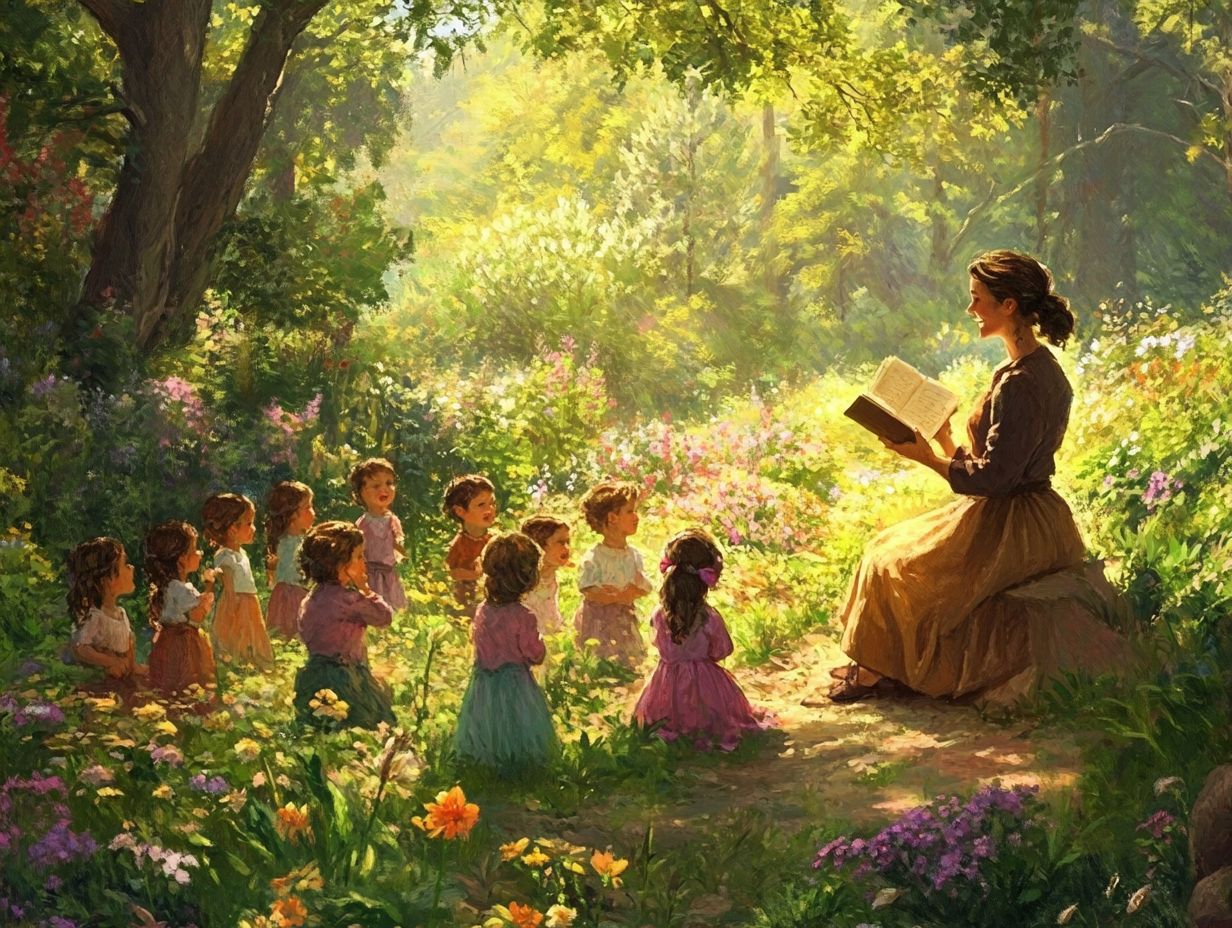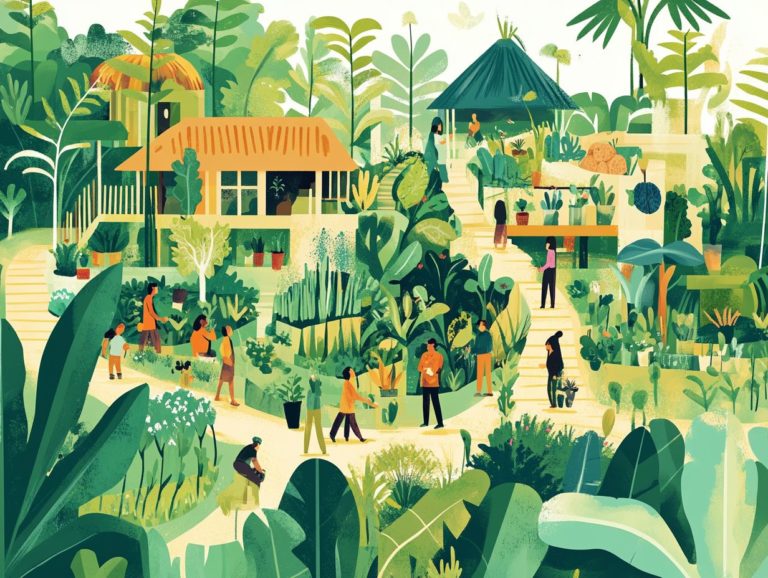54. The Power of Storytelling in Permaculture
Storytelling plays a crucial role in permaculture. It strengthens community resilience and bridges cultural divides, especially for refugees in Australia who are embarking on new journeys through initiatives like RAW Garden.
Personal anecdotes and cultural heritage are woven into storytelling. This fosters emotional healing and empowers women, resulting in a vibrant tapestry of collective narratives. These stories inspire social innovation and advocate for sustainable living practices, such as urban agriculture, creating a more connected and resilient community.
Contents
- The Power of Storytelling
- Key Takeaways:
- Using Storytelling to Teach Permaculture
- Examples of Storytelling in Permaculture
- The Impact of Storytelling on Permaculture
- Tips for Effective Storytelling in Permaculture
- The Future of Storytelling in Permaculture
- Frequently Asked Questions
- What is the power of storytelling in permaculture?
- How does storytelling benefit permaculture practices?
- Can storytelling be used as a tool for education in permaculture?
- What types of stories are commonly used in permaculture?
- How Can Storytelling Be Integrated into Permaculture Design?
- Is Storytelling Only Important for Traditional Permaculture Practices?
Defining Permaculture and its Principles
Permaculture is a design system that invites you to create sustainable living environments, mirroring the rich complexity of natural ecosystems. It addresses both community resilience and your individual needs through principles like working together and clear communication.
At its heart, permaculture encourages you to align your activities with nature’s cycles. This fosters not just environmental health but also social well-being. By nurturing an ethos of empathy, you can help cultivate relationships that prioritize mutual support and understanding.
Consider community gardens: they become vibrant spaces where neighbors collaborate to grow food, share produce, and participate in educational workshops. These initiatives create an urgent sense of belonging, showcasing the power of collaboration to innovate sustainable practices and improve local food security now!
The Power of Storytelling
The power of storytelling resides in its remarkable ability to forge deep emotional connections between individuals. It crafts engaging narratives that not only cultivate empathy but also reflect cultural values.
Storytelling is a transformative tool for anyone wanting to create change in their community.
Why Storytelling is Effective in Permaculture
Storytelling shines in permaculture because it masterfully simplifies complex ideas, enhancing communication skills and fostering community engagement while preserving cultural narratives that enrich sustainable practices.
In the realm of permaculture, narratives do more than just share valuable knowledge; they forge connections between you and your local environment. By recounting personal experiences and lessons learned from nature, you cultivate a sense of belonging and shared purpose within your community.
Imagine a farmer sharing how integrating chickens into crop rotation has revitalized soil health and boosted biodiversity. That story lingers in the mind far longer than mere statistics ever could. Such narratives have the power to inspire you and others to embrace similar practices, illustrating that sustainable methods are not only practical but also intricately woven into cultural identity.
By intertwining anthropology with ecology, storytelling transforms into a potent tool for creating real change and promoting resilience in your community.
Key Takeaways:

- The power of storytelling lies in its ability to inspire and motivate change in permaculture practices.
- By incorporating stories into permaculture education, practitioners can effectively teach and engage learners in permaculture principles.
- As a form of communication and education, storytelling has the potential to shape the future of permaculture and promote sustainable living.
Using Storytelling to Teach Permaculture

Utilizing storytelling to teach permaculture offers a dynamic and engaging approach to grasp complex ecological concepts. This method helps you connect with the material on a deeper level, especially during storytelling workshops guided by knowledgeable community advisors.
Incorporating Stories into Permaculture Education
Incorporating stories into your permaculture education can elevate the learning experience by enhancing storytelling and fostering effective communication among participants.
This approach leads to stronger community building and creates a vibrant atmosphere of collaboration. Engaging in collaborative projects allows individuals to share their unique experiences.
By weaving personal narratives and local histories into your workshops, you can craft a compelling framework that draws participants in, cultivating a shared understanding of ecological principles.
Community storytelling initiatives enable diverse voices to emerge, showcasing individual and cultural wisdom. When these insights are integrated with permaculture practices, they enrich the curriculum and inspire sustainable action.
This synergistic approach deepens engagement and reinforces the bond between learners and the land they inhabit.
Examples of Storytelling in Permaculture
You can find compelling examples of storytelling in permaculture through a multitude of real-life success stories. These narratives illuminate community-driven initiatives, showcase the profound impact of emotional healing, and reveal the remarkable transformation of urban landscapes into vibrant ecosystems.
Real-Life Stories of Permaculture Success
Real-life stories of permaculture success often present inspiring accounts of community resilience and women’s empowerment, much like the transformative work happening at RAW Garden in Australia.
This initiative teaches sustainable agricultural practices and nurtures a profound sense of unity among its participants. Women from indigenous backgrounds come together to share traditional knowledge while honing new skills in permaculture design.
In areas grappling with social dislocation, the narratives emerging from RAW Garden illustrate how ecological education can serve as a catalyst for emotional healing. This allows women to reclaim their heritage and boost their confidence, turning them into change agents.
Such experiences empower marginalized voices, transforming them into leaders within their communities. This benefits not just the environment but also enhances social cohesion and collective resilience through their storytelling journeys.
Join these inspiring women and be part of this transformative journey!
The Impact of Storytelling on Permaculture
The impact of storytelling on permaculture is transformative. It inspires meaningful change and fosters a profound sense of shared purpose within the community, rooted in cultural heritage and collective narratives, such as those highlighted in building community resilience through permaculture.
How Stories Can Inspire and Motivate Change

Stories possess a remarkable ability to inspire and motivate change within a community. They weave emotional experiences together and foster resilience through shared narratives.
When you share your personal journey, it creates deep emotional resonance that can ripple through your entire community. These narratives encourage empathy, allowing listeners to view the world from different perspectives and inspiring collective action.
For instance, tales of triumph over adversity can galvanize groups to confront shared challenges, nurturing a sense of unity. Storytelling serves as a powerful tool for advocating social change, illuminating injustices and igniting passion within those who hear it.
This interconnectedness strengthens community bonds and empowers individuals like you to take action, cultivating hope and resilience through collective narratives.
Explore storytelling in your own community and participate in workshops that can change lives!
Tips for Effective Storytelling in Permaculture
Effective storytelling in permaculture can greatly enhance your message delivery and retention. Employ techniques like engaging stories, emotional appeals, and relatable content, especially in storytelling practices.
These methods resonate deeply within community settings. They make your stories not only memorable but also impactful, reinforcing the importance of collaboration.
Techniques for Crafting Compelling Stories
Techniques for crafting compelling stories in permaculture invite you to harness empathy and incorporate personal anecdotes. Woven together with cultural values, these stories resonate with your community members, maximizing their storytelling impact.
By skillfully blending these elements, you can create a tapestry of experiences that captures attention and fosters a deeper emotional connection among your listeners. For instance, when you share personal journeys of transformation in sustainable gardening, you inspire others to envision their own potential impacts.
Using culturally relevant symbols and references reinforces shared values. It reminds everyone of their collective identity and mission. These storytelling techniques educate, encourage collaborative action, and ultimately strengthen the bonds within the community, cultivating a more resilient, engaged environment.
The Future of Storytelling in Permaculture
The future of storytelling in permaculture is bursting with exciting opportunities as it evolves and adapts to meet contemporary needs. This dynamic approach offers innovative avenues for communities like yours to engage in meaningful conversations about sustainable practices.
By weaving shared stories, you can enhance resilience and foster a deeper connection to the principles of permaculture. This ultimately enriches both your community and the environment.
How Storytelling Will Continue to Shape Permaculture Practices
Storytelling will play a pivotal role in shaping your permaculture practices. It acts as a vital tool for cultural preservation and community engagement, ensuring that valuable lessons and experiences are passed down through generations.
Weaving narratives around sustainable farming techniques and ecological principles helps create a rich tapestry of knowledge that honors both the land and its history. Engaging local residents in these stories deepens their connection to permaculture and sparks innovation.
Through oral histories, workshops, and community gatherings, individuals can share unique insights on biodiversity and natural resource management. This collective storytelling reinforces cultural identities and cultivates resilience against environmental challenges, uniting voices that advocate for sustainable practices in the region.
Frequently Asked Questions

What is the power of storytelling in permaculture?
The power of storytelling in permaculture lies in its ability to share knowledge, inspire action, and highlight the power of community in permaculture design, fostering a deeper connection to the land and its inhabitants.
How does storytelling benefit permaculture practices?
Storytelling transmits traditional ecological knowledge, promotes community engagement and collaboration, and encourages the preservation of cultural and ecological diversity.
Can storytelling be used as a tool for education in permaculture?
Absolutely! Stories have been used for centuries to pass down information and teachings. In permaculture, storytelling helps educate both children and adults about sustainable living and regenerative practices.
What types of stories are commonly used in permaculture?
Folktales, myths, and personal anecdotes are often used in permaculture to convey important lessons and concepts. These stories have been passed down through generations and have a strong cultural and emotional impact.
Join us in sharing your stories! Let s cultivate our community together!
How Can Storytelling Be Integrated into Permaculture Design?
Storytelling transforms permaculture design. It engages the community and connects people to the land and its resources.
Is Storytelling Only Important for Traditional Permaculture Practices?
No, storytelling is crucial for all types of permaculture. It educates and inspires everyone about sustainable living and regenerative practices.






